Search Result
Results for "
Maleic acid
" in MedChemExpress (MCE) Product Catalog:
4
Biochemical Assay Reagents
7
Isotope-Labeled Compounds
| Cat. No. |
Product Name |
Target |
Research Areas |
Chemical Structure |
-
- HY-Y0367
-
|
|
|
|
|
Maleic Acid is a Glutamate Decarboxylase (GAD) inhibitor of E. coli and L. monocytogenes.
|
-
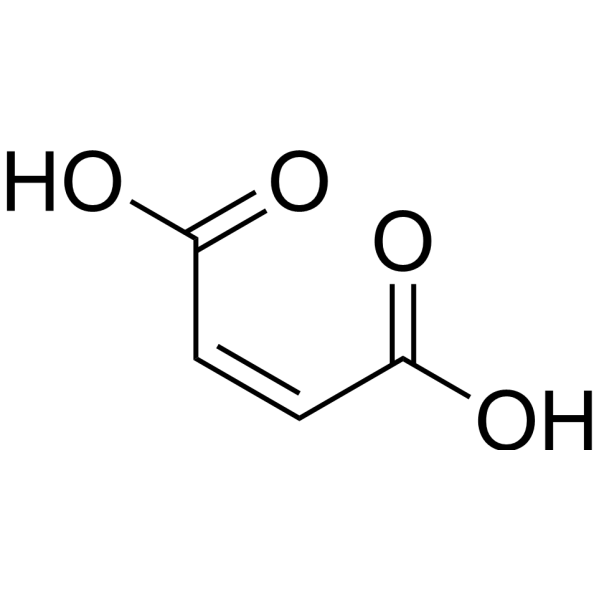
-
- HY-Y1147
-
|
Maleic acid diethyl ester
|
|
|
|
Diethyl maleate is a maleate ester resulting from the formal condensation of both carboxy groups of maleic acid with ethanol. Diethyl maleate (DEM), a thiol-reactive α,β-unsaturated carbonyl compound, depletes glutathione (GSH) in exposed cells .
|
-
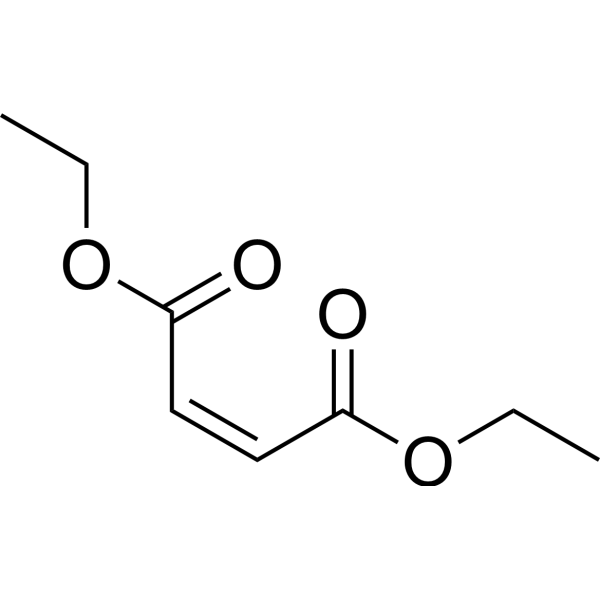
-
- HY-Y0367S
-
|
Maleic-2,3-d2 acid
|
Bacterial
Endogenous Metabolite
|
Infection
|
|
Maleic Acid-d2 is the deuterium labeled Maleic Acid[1]. Maleic Acid is a Glutamate Decarboxylase (GAD) inhibitor of E. coli and L. monocytogenes[2][3].
|
-
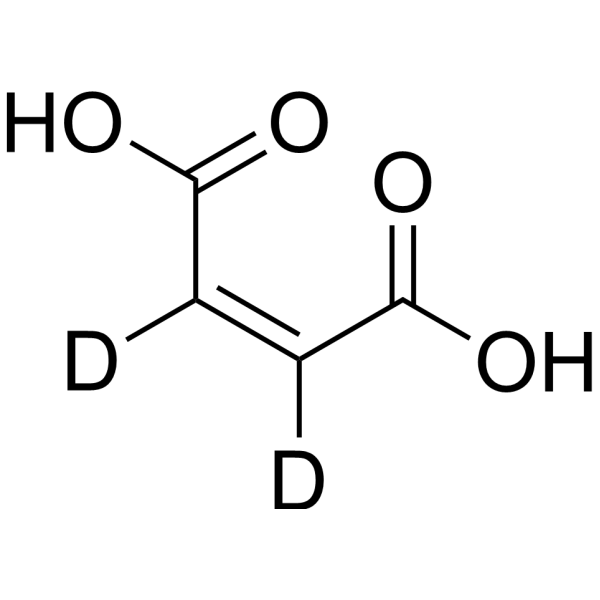
-
- HY-W127447
-
|
Maleic acid sodium
|
Biochemical Assay Reagents
|
Others
|
|
Maleic acid sodium salt is a biochemical reagent that can be used as a biological material or organic compound for life science related research.
|
-

-
- HY-59354R
-
|
|
DNA/RNA Synthesis
|
Cancer
|
|
Maleic hydrazide (Standard) is the analytical standard of Maleic hydrazide. This product is intended for research and analytical applications. Maleic hydrazide is extensively used as a systemic plant growth regulator and as a herbicide. Maleic hydrazide acts as an inhibitor of the synthesis of nucleic acids and proteins .
|
-

-
- HY-59354
-
|
|
DNA/RNA Synthesis
|
Cancer
|
|
Maleic hydrazide is extensively used as a systemic plant growth regulator and as a herbicide. Maleic hydrazide acts as an inhibitor of the synthesis of nucleic acids and proteins .
|
-
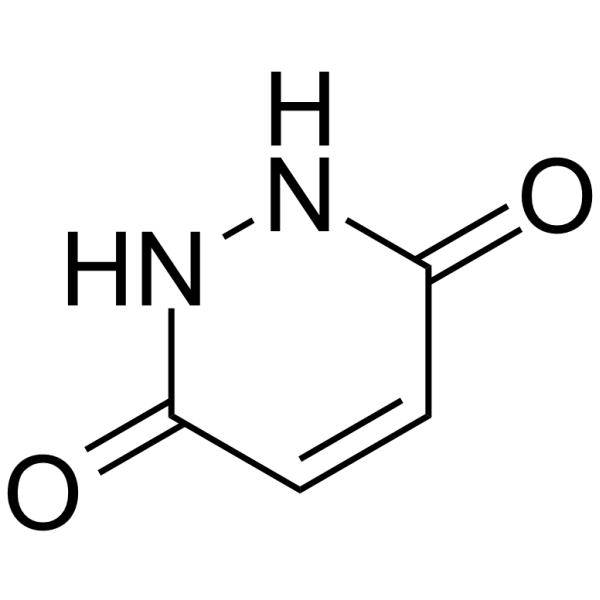
-
- HY-59354S
-
|
|
DNA/RNA Synthesis
|
Cancer
|
|
Maleic hydrazide-d2 is the deuterium labeled Maleic hydrazide[1]. Maleic hydrazide is extensively used as a systemic plant growth regulator and as a herbicide. Maleic hydrazide acts as an inhibitor of the synthesis of nucleic acids and proteins[2][3].
|
-

-
- HY-15284B
-
|
PCR 4099 (Maleic acid)
|
P2Y Receptor
|
Cardiovascular Disease
|
|
Prasugrel (PCR 4099) Maleic acid is a thienopyridine and proagent, inhibits platelet function. Prasugrel Maleic acid is an orally active and potent P2Y12 receptor antagonist, and inhibits ADP-induced platelet aggregation .
|
-
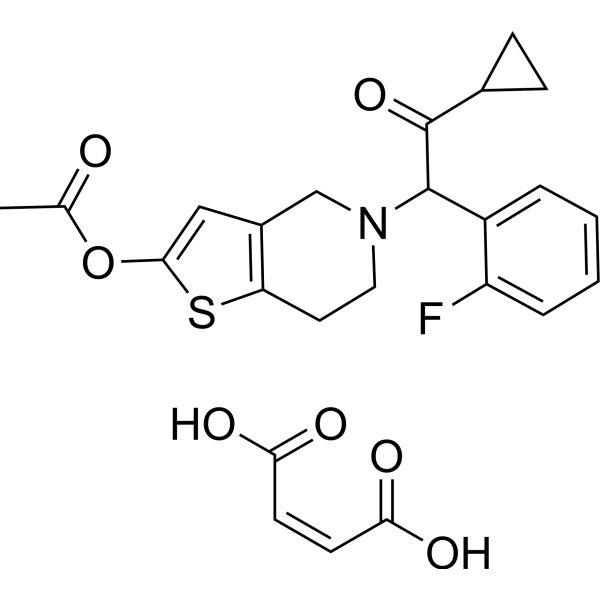
-
- HY-W127723
-
|
|
Biochemical Assay Reagents
|
Others
|
|
Fluoresceinamine Maleic Acid Monoamide is a biochemical reagent that can be used as a biological material or organic compound for life science related research.
|
-
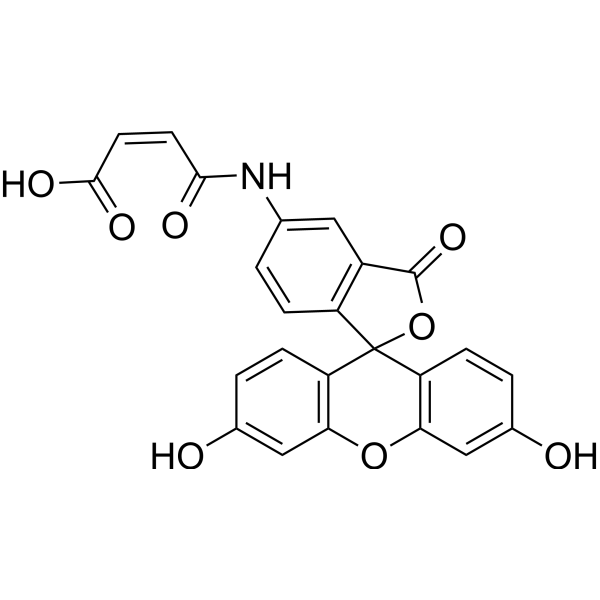
-
- HY-20558
-
-
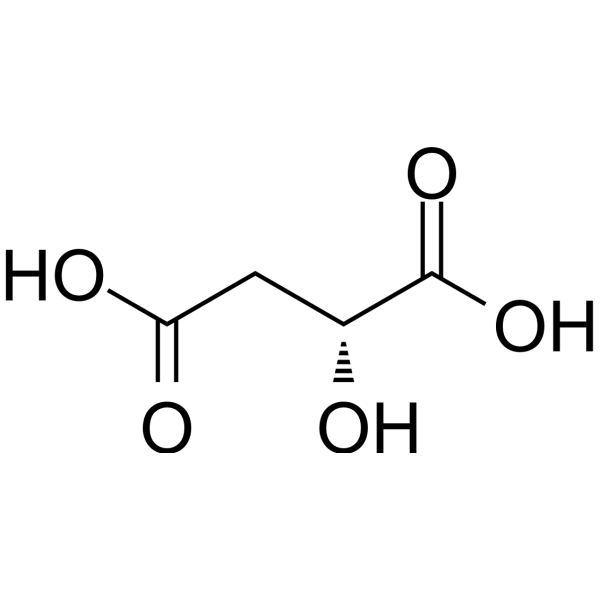
-
- HY-Y1311S
-
|
Hydroxybutanedioic acid-d3; E 296-d3
|
Endogenous Metabolite
|
Others
|
|
Malic acid-d3 is the deuterium labeled Malic acid. Malic acid (Hydroxybutanedioic acid) is a dicarboxylic acid that is naturally found in fruits such as apples and pears. It plays a role in many sour or tart foods[1][2].
|
-
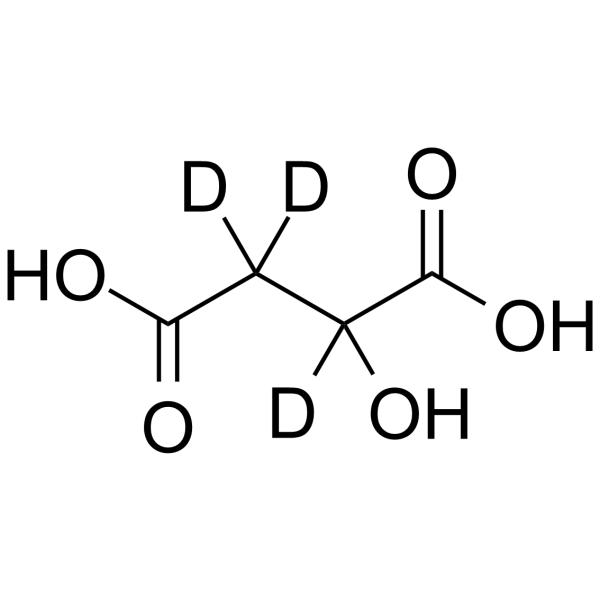
-
- HY-Y1069S3
-
-

-
- HY-128900
-
|
|
Endogenous Metabolite
|
Others
|
|
11-cis-Vaccenyl acetate is male-specific lipid that mediates aggregation behavior in both male and female flies, which activates a few dozen olfactory neurons located in T1 sensilla on the antenna of both male and female flies .
|
-
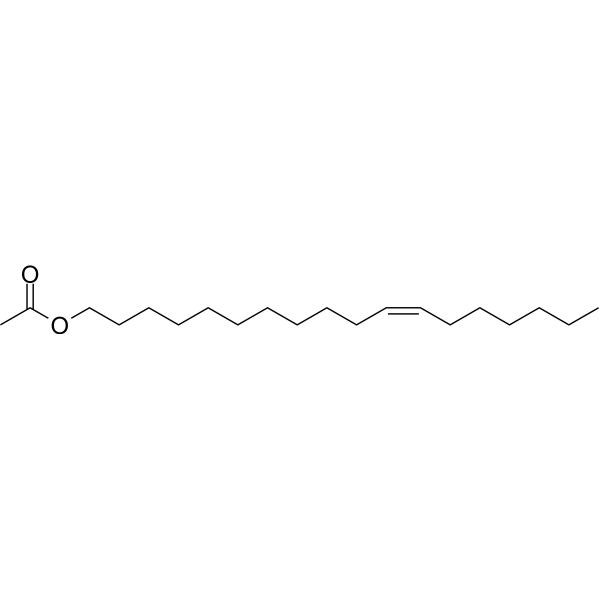
-
- HY-Y1069S
-
|
(S)-Hydroxybutanedioic acid-d3; (S)-E 296-d3
|
Endogenous Metabolite
|
Metabolic Disease
|
|
(S)-Malic acid-d3 is the deuterium labeled (S)-Malic acid. (S)-Malic acid ((S)-2-Hydroxysuccinic acid) is a dicarboxylic acid in naturally occurring form, contributes to the pleasantly sour taste of fruits and is used as a food additive[1][2].
|
-

-
- HY-124861
-
|
ME1
|
Others
|
Metabolic Disease
Cancer
|
|
Malic enzyme inhibitor ME1 (ME1; compound 1) is a potent inhibitor of Malic enzyme (ME1) with an IC50 of 0.15 μM .
|
-
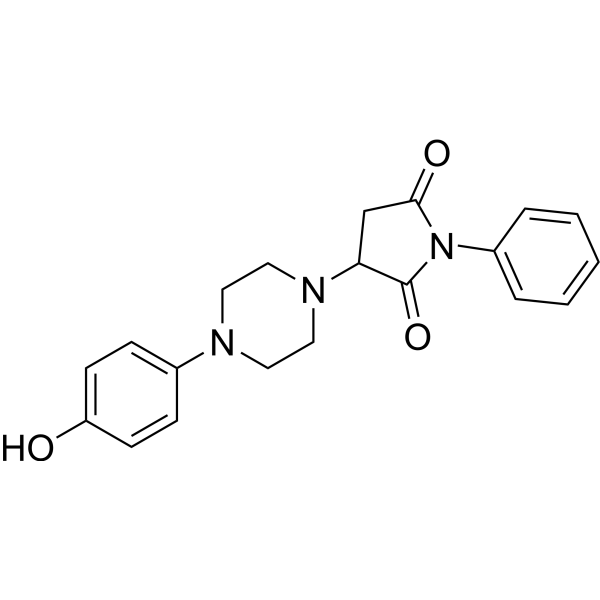
-
- HY-W250305
-
-
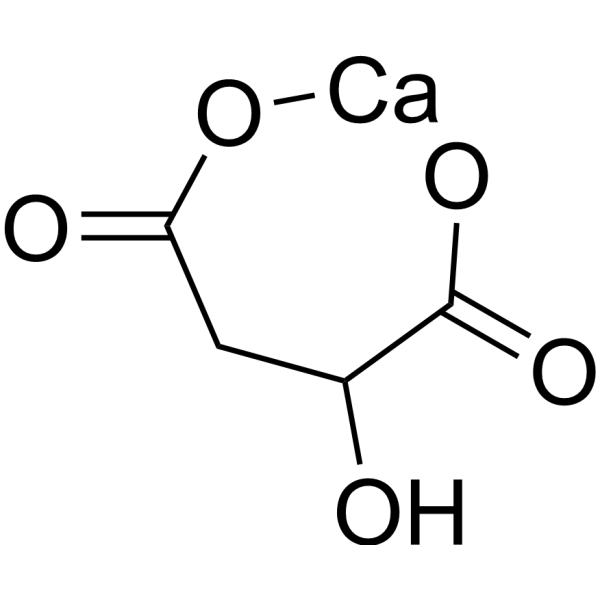
-
- HY-116047
-
|
p-Methoxybenzylacetone
|
Others
|
Others
|
|
Anisylacetone (p-Methoxybenzylacetone) is a male fruit fly attractant .
|
-
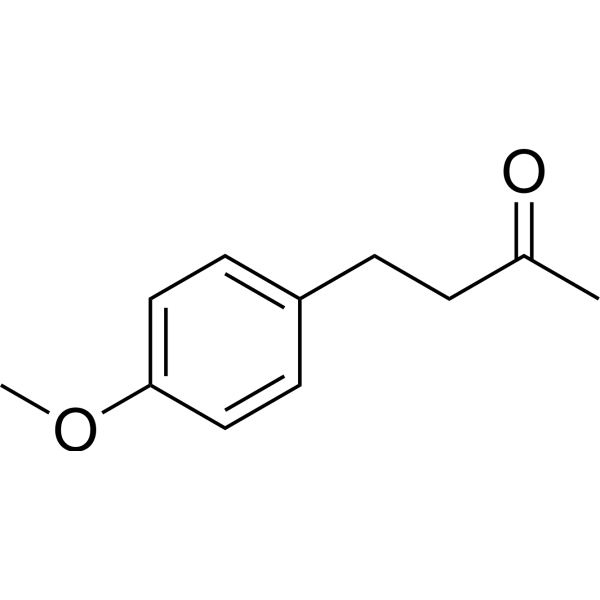
-
- HY-P5719
-
|
|
Bacterial
|
Infection
|
|
Andropin is a male-specific antibacterial peptide that can be found in Drosophila melanogaster .
|
-

-
- HY-16743A
-
|
Venglustat (L-Malic acid); SAR402671 (L-Malic acid); GZ402671 (L-Malic acid)
|
Glucosylceramide Synthase (GCS)
|
Metabolic Disease
|
|
Ibiglustat (Venglustat) L-Malic acid is an orally active, brain-penetrant glucosylceramide synthase (GCS) inhibitor. Ibiglustat L-Malic acid can be used for the research of Gaucher disease type 3, Parkinson's disease associated with GBA mutations, Fabry disease, GM2 gangliosidosis, and autosomal dominant polycystic kidney disease .
|
-
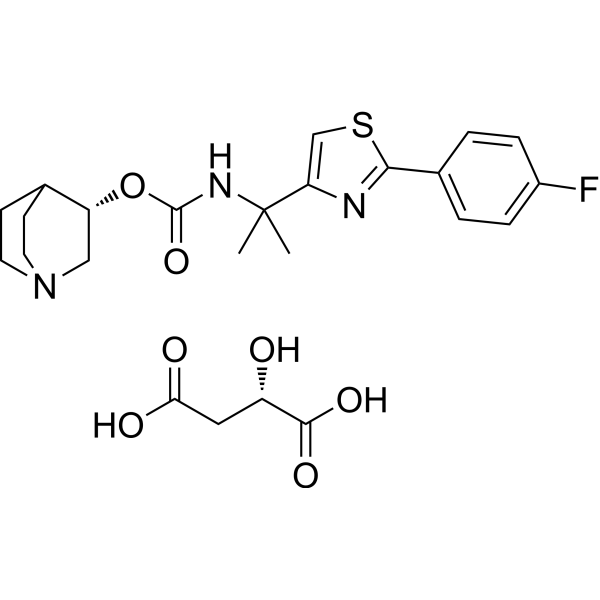
-
- HY-Y1311
-
|
Hydroxybutanedioic acid; E 296
|
|
|
|
Malic acid (Hydroxybutanedioic acid) is a dicarboxylic acid that is naturally found in fruits such as apples and pears. It plays a role in many sour or tart foods.
|
-
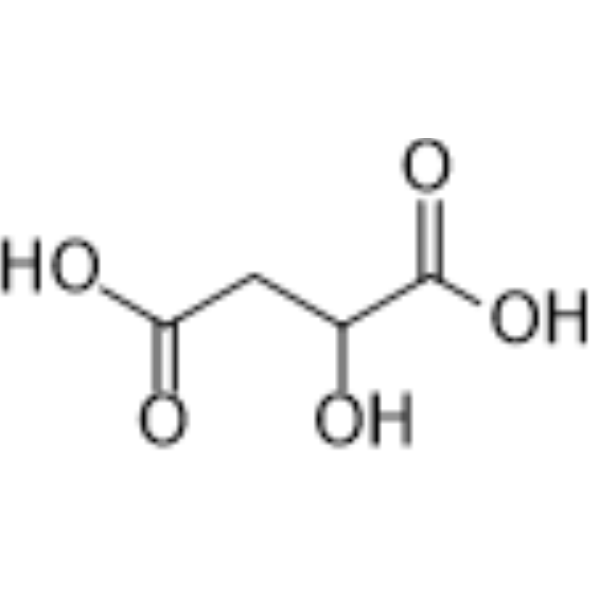
-
- HY-18996
-
-

-
- HY-150621
-
|
|
Others
|
Cancer
|
|
AS1134900 is a highly selective, allosteric and uncompetitive NADP +-dependent malic enzyme 1 (ME1) inhibitor .
|
-
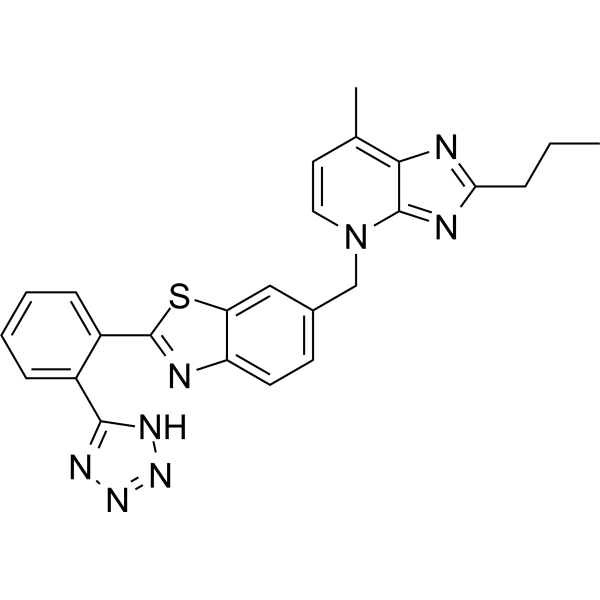
-
- HY-W780790
-
|
|
Others
|
Others
|
|
(Z,Z)-3,13-Octadecadienyl acetate is a compound that can be isolated from the pheromone gland extracts of female S. bicingulata moths. (Z,Z)-3,13-Octadecadienyl acetate is essential for attraction of male S. bicingulata moths. (Z,Z)-3,13-Octadecadienyl acetate can be used as bait to trap male moths .
|
-

-
- HY-101812
-
|
|
Others
|
Metabolic Disease
|
|
Terbufibrol has been shown highly active in reducing serum total cholesterol (TC) levels in the normal and hypercholesterolemic male rat.
|
-

-
- HY-W009688
-
|
|
Others
|
Inflammation/Immunology
|
|
Dibutyl maleate, the diester of the Maleic Acid, can be used as an intermediate of pharmaceutical synthesis. Dibutyl maleate can enhance contact sensitization to Fluorescein isothiocyanate in mice .
|
-

-
- HY-W250303
-
|
Hydroxybutanedioic acid disodium salt; E 296 disodium salt
|
Biochemical Assay Reagents
|
Others
|
|
Sodium DL-Malate is an organic compound commonly used as a food additive, buffer and nutritional supplement. It contains sodium and malic acid. Malic acid disodium salt has several properties suitable for these applications, including the ability to enhance food flavor, improve texture and regulate acidity. Additionally, it can be used as a dietary supplement due to its potential health benefits, including improved energy production, reduced fatigue, and enhanced athletic performance.
|
-
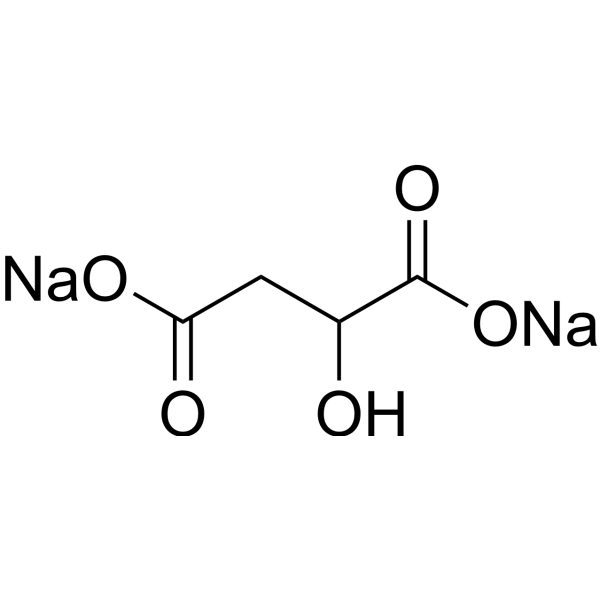
-
- HY-Y1069
-
|
(S)-Hydroxybutanedioic acid; (S)-E 296
|
|
|
|
(S)-Malic acid ((S)-2-Hydroxysuccinic acid) is a dicarboxylic acid in naturally occurring form, contributes to the pleasantly sour taste of fruits and is used as a food additive.
|
-

-
- HY-N6976
-
|
|
Others
|
Infection
|
|
Ascr#8 is an dauer-inducing ascaroside isolated from Caenorhabditis elegans, synergizes with ascr#2 and ascr#3, and strongly enhances male attraction .
|
-
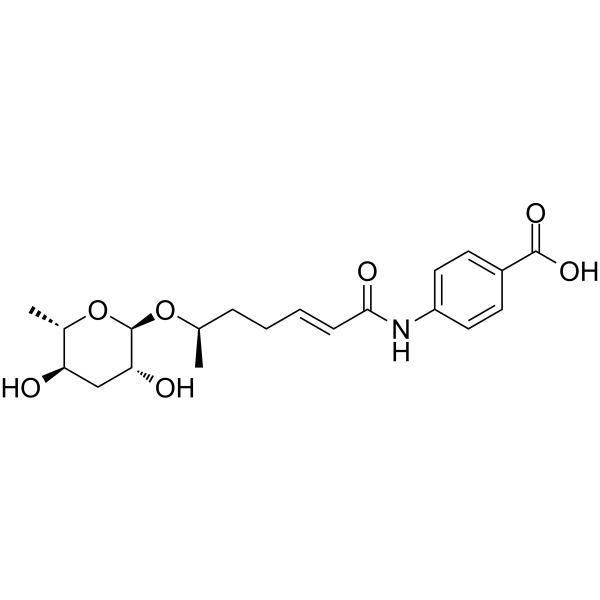
-
- HY-W751152
-
|
|
Others
|
Cancer
|
|
α,β-Thujone is a component of the essential oils of some plants. α,β-Thujone causes cancers in male rats and induces seizures in the highest doses .
|
-

-
- HY-N6977
-
|
|
Others
|
Infection
|
|
Ascr#3 is an ascaroside isolated from Caenorhabditis elegans, acts a potent male attractant, and also promotes dauer formation combined with ascr#2 at low concentration .
|
-
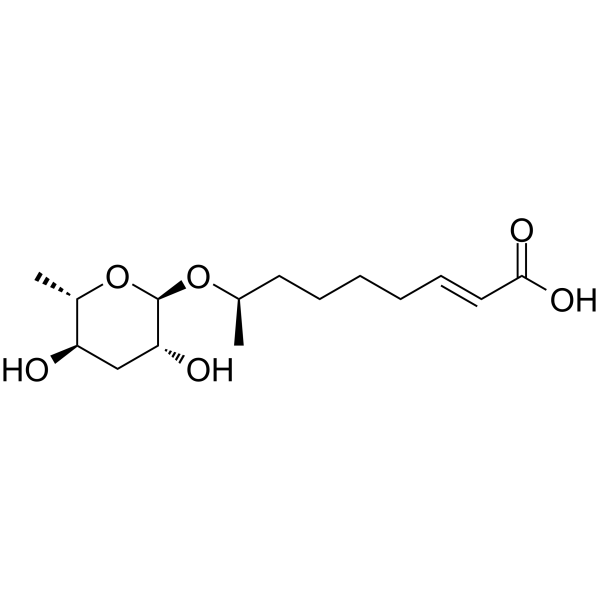
-
- HY-N6974
-
|
Ascaroside C6
|
Others
|
Infection
|
|
Ascr#2 is an ascaroside isolated from Caenorhabditis elegans, potently promotes dauer formation, and also acts as a potent male attractant combined with ascr#3 at low concentration .
|
-

-
- HY-W087952
-
|
|
Others
|
Metabolic Disease
|
|
(R)-(-)-2-Butanol is released by the females of the white grub beetle, Dasylepida ishigakiensis, to attract males. (R)-(-)-2-Butanol is an intermediate of pharmaceutical synthesis by coupling .
|
-
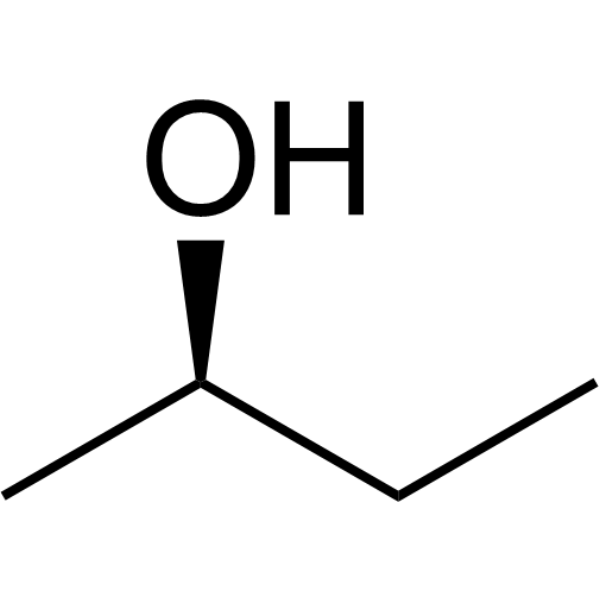
-
- HY-120989
-
|
|
Others
|
Metabolic Disease
|
|
Methyl 7(Z)-hexadecenoate is a sex pheromone produced by Trogoderma glabrum. Methyl 7(Z)-hexadecenoate can elicit attractive and sexually excitatory responses in Trogoderma glabrum males .
|
-
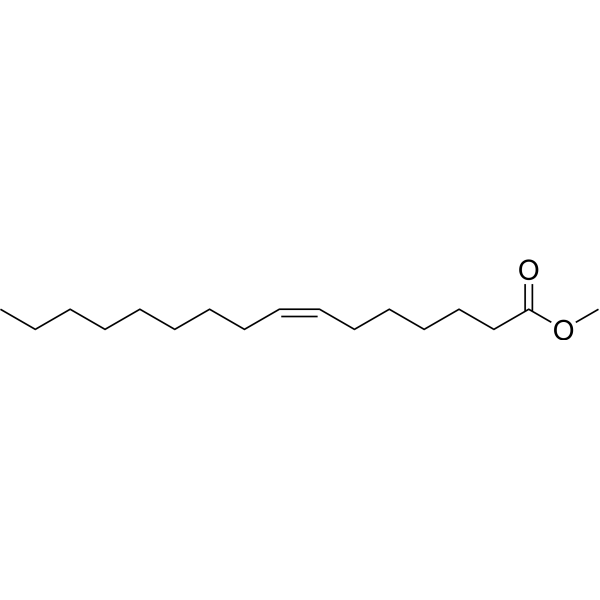
-
- HY-B0860
-
|
|
|
|
|
Diuron is a phenylurea herbicide that inhibits photosynthesis by preventing the formation of ATP and NADH. Diuron (2,500 ppm, dietary) increases the incidence of urinary bladder urothelial carcinomas in male and female mice by 73 and 27%, respectively.
|
-
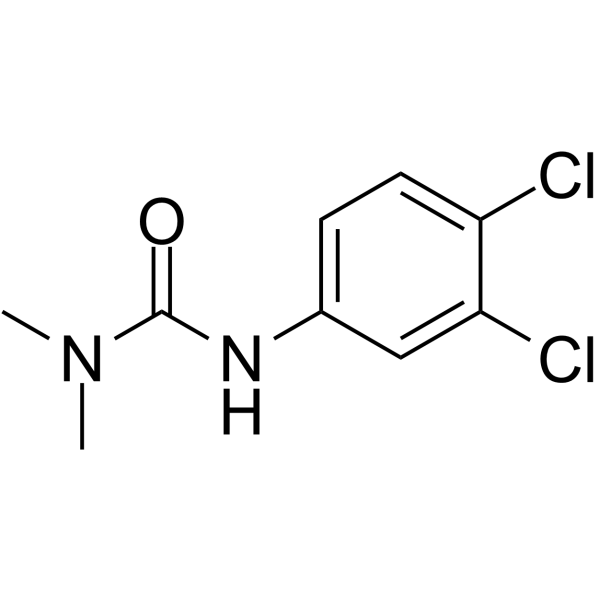
-
- HY-32004
-
|
|
Biochemical Assay Reagents
|
Others
|
|
Coumalic acid is a valuable platform compound which can be prepared from malic acid. Coumalic acid can be used in the flavours, fragrances and cosmetics industries, as polymer components, and as pharmaceutical scaffolds displaying anti-bronchial and -malarial activity .
|
-
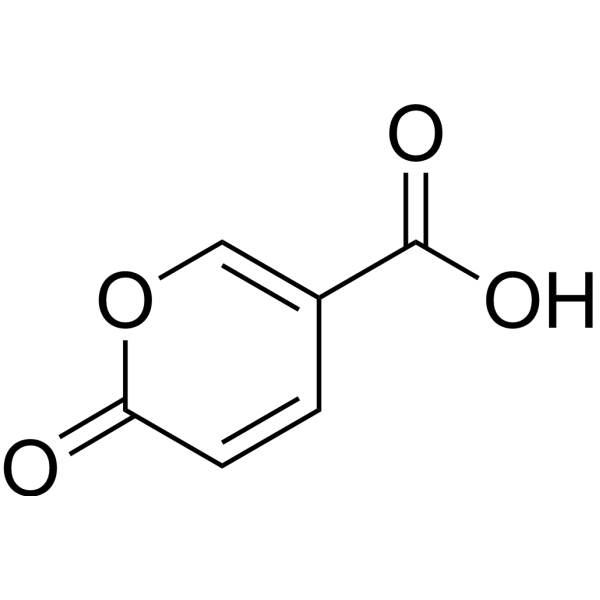
-
- HY-118861
-
|
(E)-Clomiphene; trans-Clomiphene; Enclomifene
|
Estrogen Receptor/ERR
|
Metabolic Disease
Endocrinology
|
|
Enclomiphene ((E)-Clomiphene) is a potent and orally active non-steroidal estrogen receptor antagonist, with antioestrogenic property. Enclomiphene can be used for the research of ovarian dysfunction, testosterone deficiency, male hypogonadism and type 2 diabetes .
|
-
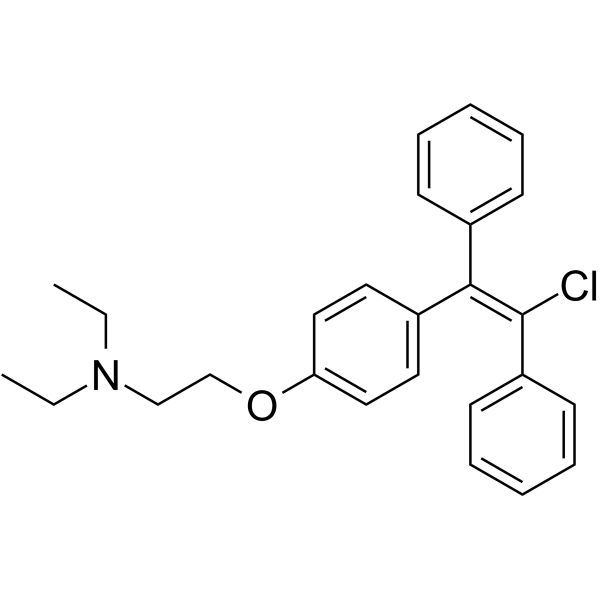
-
- HY-118861B
-
|
(E)-Clomiphene hydrochloride; trans-Clomiphene hydrochloride; Enclomifene hydrochloride
|
Estrogen Receptor/ERR
|
Metabolic Disease
Endocrinology
|
|
Enclomiphene ((E)-Clomiphene) hydrochloride is a potent and orally active non-steroidal estrogen receptor antagonist, with antioestrogenic property. Enclomiphene hydrochloride can be used for the research of ovarian dysfunction, testosterone deficiency, male hypogonadism and type 2 diabetes .
|
-
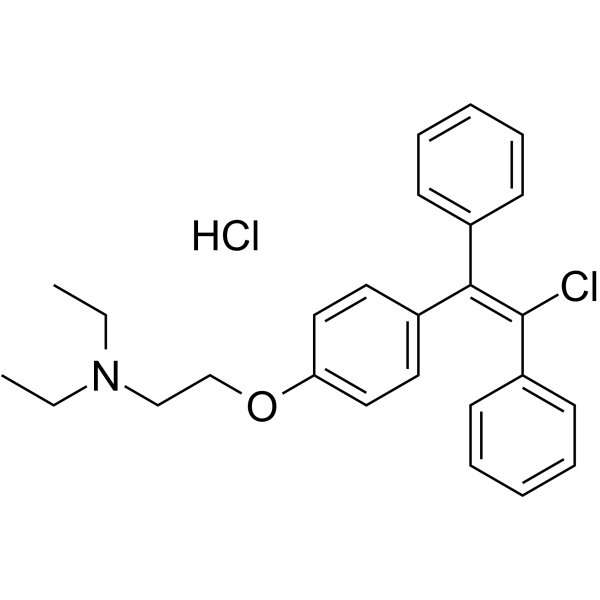
-
- HY-N8028
-
|
|
Others
|
Cancer
|
|
Quercetin-3-O-sambubioside is a monomeric compound found in Eucommia ulmoides male flowers. Quercetin-3-O-sambubioside promotes the stimulation of the nerve center. Antioxidant and anticancer activities .
|
-
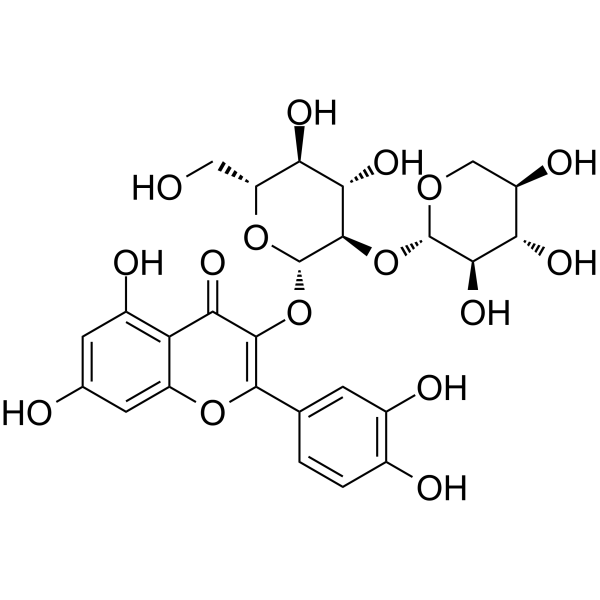
-
- HY-119419S
-
|
|
Cholinesterase (ChE)
Parasite
Isotope-Labeled Compounds
|
Others
|
|
Pirimicarb-d6 is the deuterium labeled Diuron. Diuron is a phenylurea herbicide that inhibits photosynthesis by preventing the formation of ATP and NADH. Diuron (2,500 ppm, dietary) increases the incidence of urinary bladder urothelial carcinomas in male
|
-
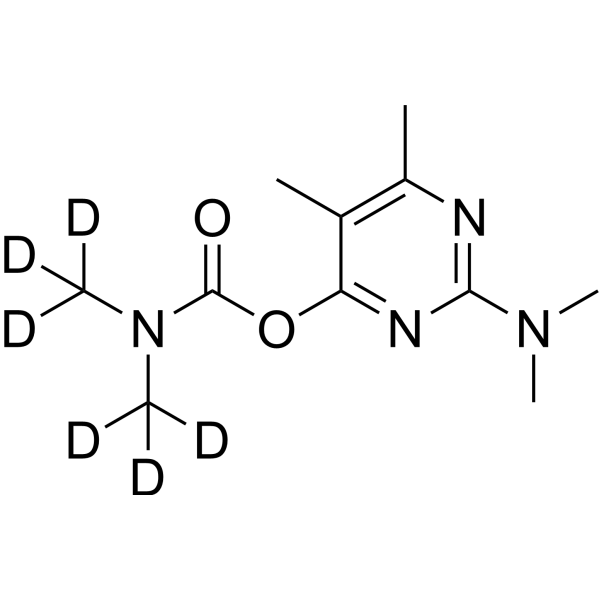
-
- HY-118861A
-
|
(E)-Clomiphene citrate; trans-Clomiphene citrate; Enclomifene citrate
|
Estrogen Receptor/ERR
|
Metabolic Disease
Endocrinology
|
|
Enclomiphene ((E)-Clomiphene) citrate is a potent and orally active non-steroidal estrogen receptor antagonist, with antioestrogenic property. Enclomiphene citrate can be used for the research of ovarian dysfunction, testosterone deficiency, male hypogonadism and type 2 diabetes .
|
-
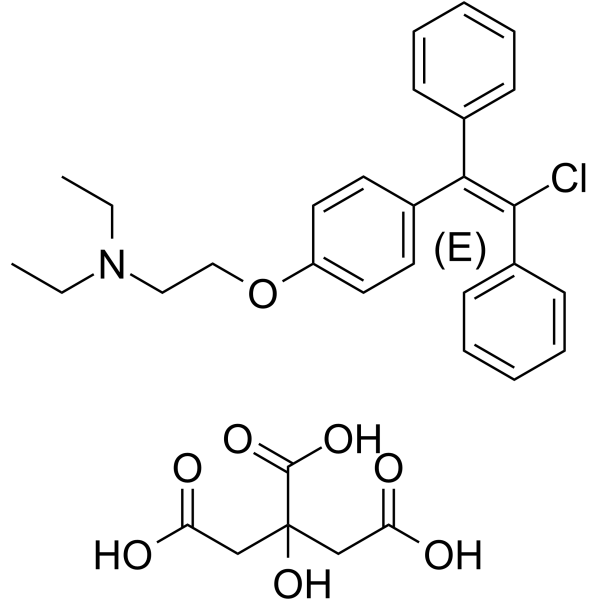
-
- HY-119332
-
|
|
Others
|
Endocrinology
|
|
3-Keto petromyzonol, a main component of Sea lamprey male sex pheromones, modulates both synthesis and release of gonadotropin releasing hormone (GnRH), and subsequently, hypothalamic-pituitary-gonadal (HPG) output in immature sea lamprey .
|
-
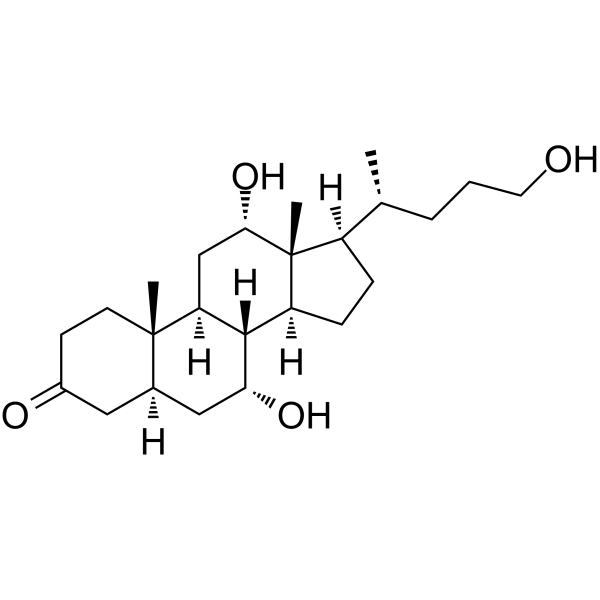
-
- HY-148163
-
|
|
Others
|
Others
|
|
Polystyrene can form Polystyrene microplastics (PS-MPs), a hazardous material with potential toxicity. Polystyrene microplastics is harm to zebrafish heart and induces male reproductive toxicity in mice . MCE provides Polystyrene products in solution packaging.
|
-

-
- HY-156280
-
|
|
RAR/RXR
|
Endocrinology
|
|
RARα antagonist 1 (compound 21) is an orally active and selective retinoic acid receptor α(RARα) antagonist, with the IC50 of 4.6nM .
|
-
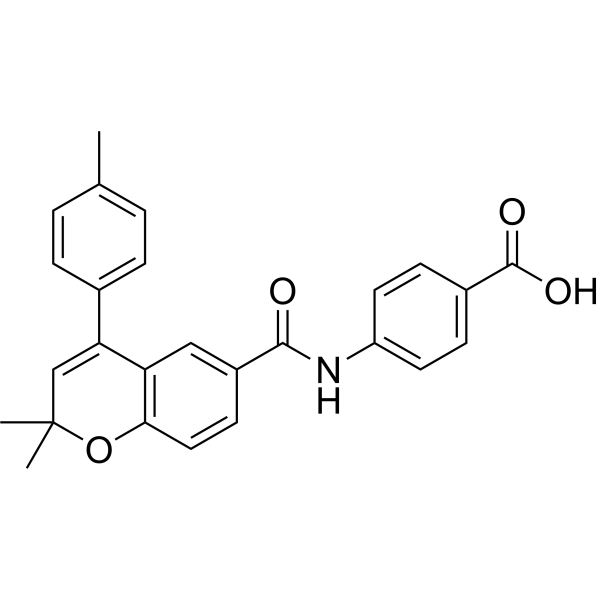
-
- HY-109517
-
|
DNA from calf thymus, Thymonucleic acid
|
DNA/RNA Synthesis
|
Inflammation/Immunology
Cancer
|
|
Calf thymus DNA (DNA from calf thymus) is high quality double-stranded template DNA isolated from the thymus of male and female calves. Calf thymus DNA can be used for the research of the interaction between DNA and agents .
|
-

-
- HY-115684
-
|
Undecan-2-ol
|
Others
|
Others
|
|
2-Undecanol (Undecan-2-ol) is a male specific volatile identified from the sap beetle Lobiopa insularis. 2-undecanol is a flower emitted volatile, used by various species of Hymenoptera as a pheromone component .
|
-
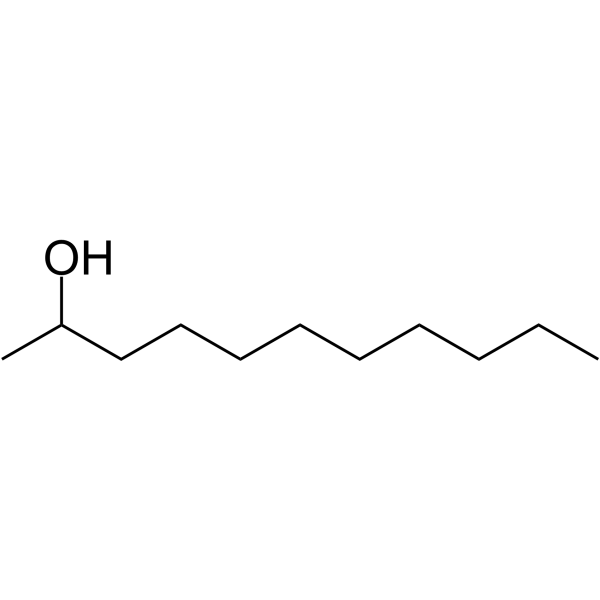
-
- HY-P5883
-
|
tatM2NX
|
TRP Channel
|
Neurological Disease
|
|
TAT-M2NX (tatM2NX) is a TRPM2 inhibitor with specific neuroprotective activity in male mice. TAT-M2NX can be used to study ischemic neuronal damage .
|
-

-
- HY-110157
-
|
|
Estrogen Receptor/ERR
|
Neurological Disease
|
|
AC-186 is a selective non-steroidal estrogen receptor β (ERβ) agonist with EC50s of 6 nM and 5000 nM for ERβ and ERα, respectively. AC-186 shows gender selective neuroprotective effects in a male rat model of Parkinson's disease .
|
-
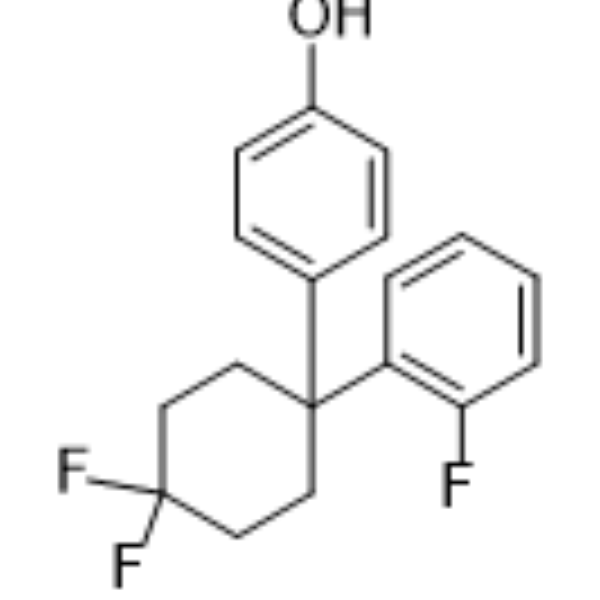
-
- HY-N6996S
-
|
|
Isotope-Labeled Compounds
|
Others
|
|
Methyl Eugenol- 13C,d3 is the 13C- and deuterium labeled Methyl Eugenol. Methyl Eugenol, a phenylpropanoid chemical in leaves, fruits, stems, and/or roots, may be released when that corresponding part of a plant is damaged as a result of feeding by an herbivore. Methyl Eugenol is used for male annihilation of the oriental fruit fly[1].
|
-

-
- HY-D0843
-
|
NEM
|
|
|
|
N-Ethylmaleimide (NEM) derives from maleic acid, it can alkylates free sulfhydryl. N-Ethylmaleimide is an irreversible cysteine protease inhibitor. N-ethylmaleimide specific inhibits phosphate transport in mitochondria. N-Ethylmaleimide inhibits prolyl endopeptidase with an IC50 value of 6.3 μM. N-Ethylmaleimide can be used to modify cysteine residues in proteins and peptides .
|
-
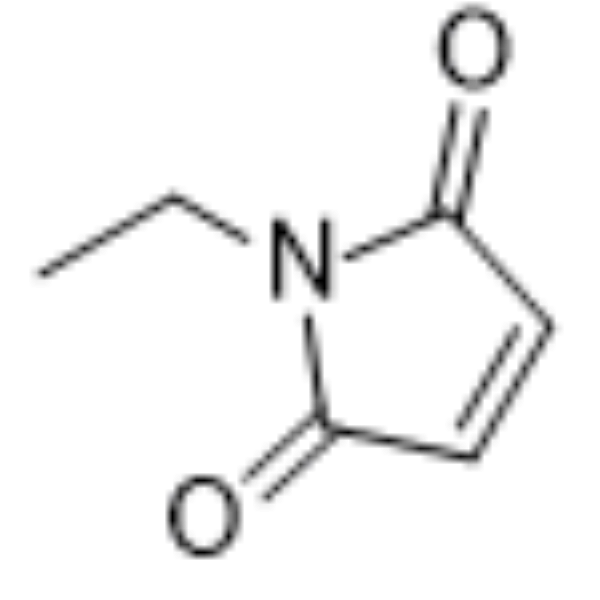
-
- HY-157429
-
|
|
5-HT Receptor
|
Neurological Disease
|
|
25N-N1-Nap (compound 16) is a β-arrestin-biased 5-HT2A agonist. 25N-N1-Nap antagonizes phencyclidine induced hyperactivity in Male C57BL/6?J mice .
|
-
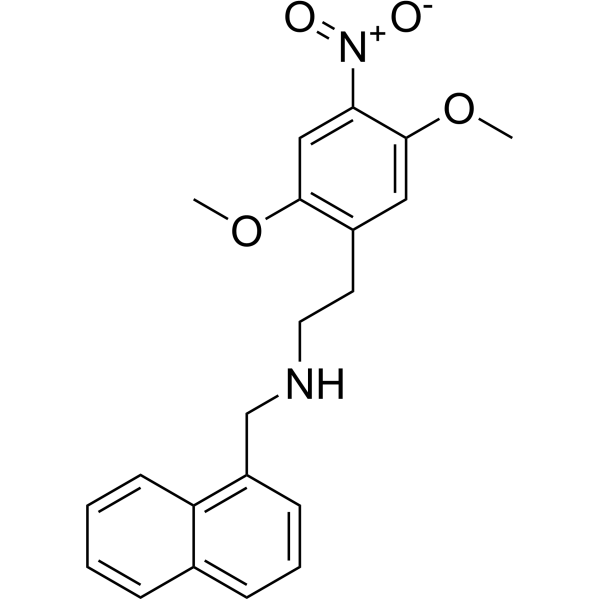
- HY-155478
-
|
|
Androgen Receptor
|
Cancer
|
|
Androgen receptor-IN-6 (compound 16) is an orally available androgen receptor (Androgen Receptor) potent inhibitor (IC50=0.12 μM in vitro), targeting the disordered N-terminal domain (NTD). Androgen receptor-IN-6 has good Caco2 cell membrane permeability and has an oral activity (F/%) of 16% in male CD-1 mice .
|
-
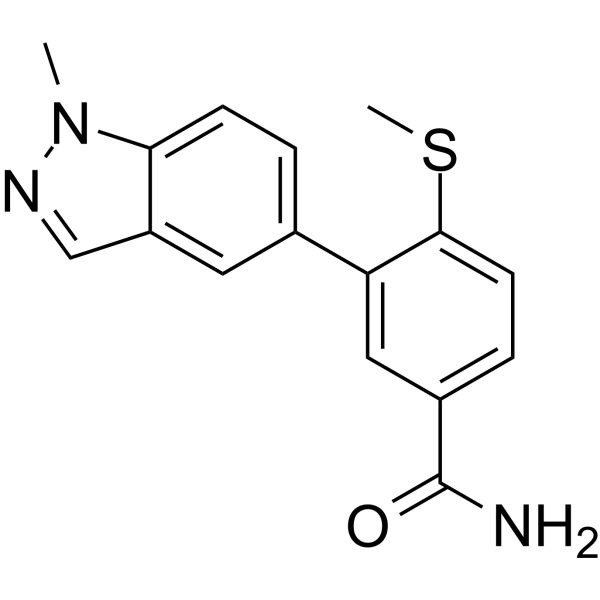
- HY-P1726A
-
|
|
Melanocortin Receptor
|
|
|
MSG606 TFA is a potent human MC1 receptor antagonist (IC50=17 nM). MSG606 TFA also partial agonist at human MC3 and MC5 receptors (EC50 values are 59 and 1300 nM, respectively). MSG606 TFA exhibits binding affinity for A375 melanoma cells in vitro. MSG606 TFA reverses the induced hyperalgesia in female mice, with no effect in male mice.
|
-
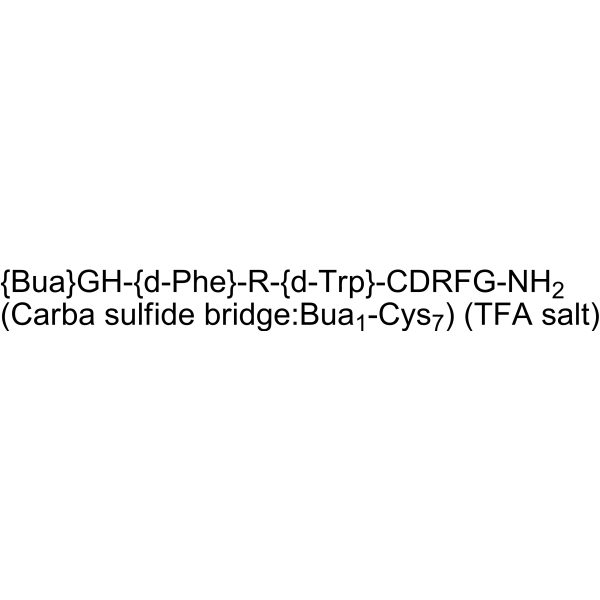
- HY-155659
-
|
|
Nuclear Hormone Receptor 4A/NR4A
|
Neurological Disease
|
|
4A7C-301 is a Nurr1 agonist with robust neuroprotective effects in vitro. 4A7C-301 significantly ameliorates neuropathological abnormalities and improves motor and olfactory dysfunctions in AAV2-mediated α-synuclein-overexpressing male mouse models. 4A7C-301 can be used for the research of Parkinson’s disease .
|
-
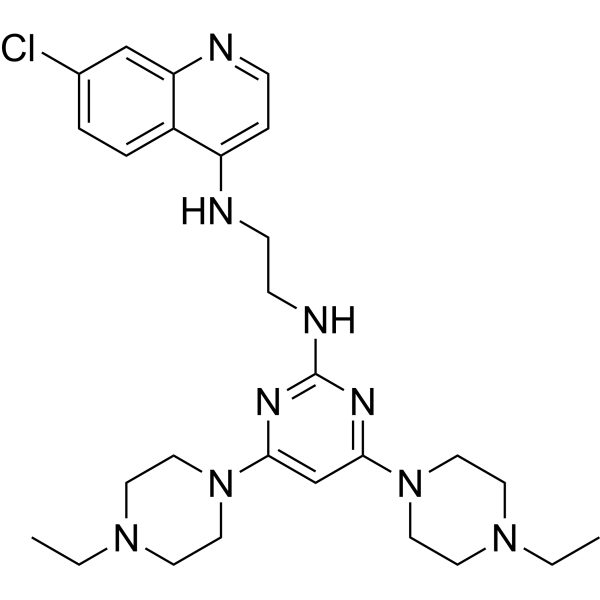
- HY-155995
-
|
MK-905
|
Others
|
Cancer
|
|
Pro-905 is a phosphite peptide with antitumor activity. Pro-905 delivers the active nucleotide antimetabolite thioguanosine monophosphate (TGMP) to the tumor. Pro-905 effectively prevents incorporation of purine salvage substrates into nucleic acids and inhibits colony formation in human malignant peripheral nerve sheath tumors (MPNST) cells. Pro-905 inhibits purine salvage incorporation to nucleic acids and prevents cell growth. Pro-905 inhibits the growth of MPNST and enhances the anti-tumor efficacy of JHU395 (HY-124778) .
|
-
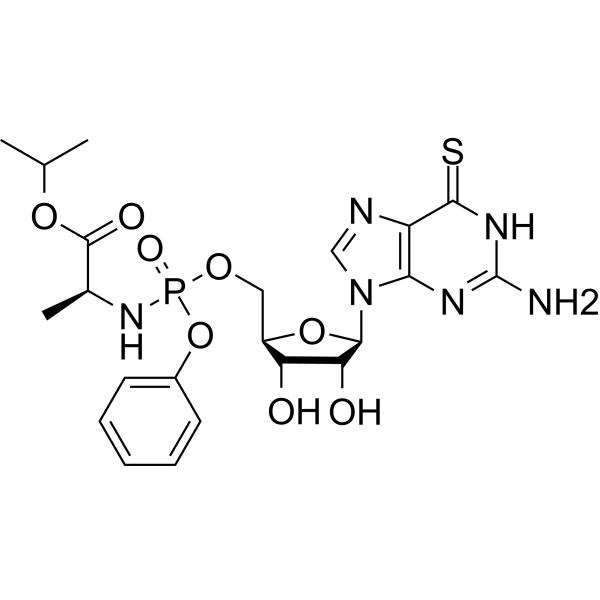
- HY-N2466
-
|
MT-I; [Nle4,D-Phe7]-α-MSH
|
Melanocortin Receptor
|
Neurological Disease
Cancer
|
|
Melanotan I is a potent non-selective melanocortin receptor (MCR) agonist. Melanotan I is a synthetic analogue of α-melanocyte stimulating hormone (α-MSH) that stimulates melanogenesis. Melanotan I can induce skin tanning by mimicking the actions of a-MSH on the melanocortin type 1 receptors (MC1R) of melanocytes. Melanotan I can be used for the research of sun-induced skin cancer, melanoma, inflammation and male erectile dysfunction .
|
-

- HY-143546
-
|
|
RET
|
Cancer
|
|
RET-IN-9 is a potent inhibitor of RET. RET kinase is a single-pass transmembrane receptor tyrosine kinase that plays an important role in the development of the kidney and enteric nervous system, and the maintenance of homeostasis in the nervous, endocrine, hematopoietic, and male reproductive systems. RET-IN-9 has the potential for the research of RET-related disease including non-small cell lung cancer and medullary thyroid cancer (extracted from patent WO2021115457A1, compound 29) .
|
-
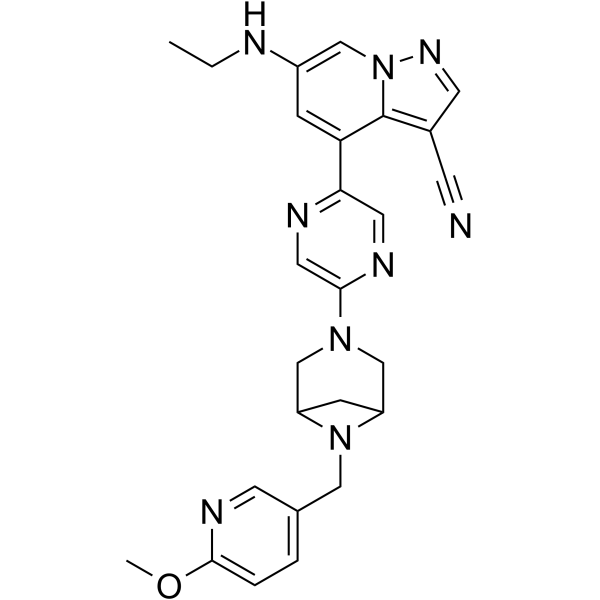
- HY-13699
-
|
|
GnRH Receptor
PERK
|
Others
|
|
NBI-42902 is an orally active, potent functional and competitive antagonist of GnRH receptor with an IC50 value of 0.79 nM, a Ki value of 0.56 nM, respectively. NBI-42902 inhibits GnRH-stimulated inositol phosphate (IP) accumulation, Ca 2+ flux, and ERK1/2 activation. NBI-42902 inhibits serum luteinizing hormone (LH) in castrated male macaques. NBI-42902 can be used for research on sex-hormone-related diseases .
|
-
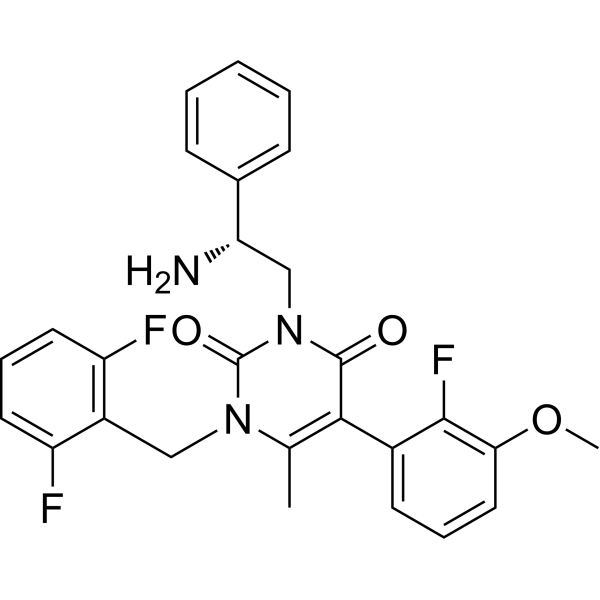
- HY-127133
-
|
MPP
|
Biochemical Assay Reagents
|
|
|
MPP is a highly selective estrogen receptor alpha (ERα) antagonist. MPP reduces the ratio of p-ERα/ERα .
https://www.ncbi.nlm.nih.gov/pubmed/29799481
Labouesse MA, et al. Effects of selective estrogen receptor alpha and beta modulators on prepulse inhibition in male mice. Psychopharmacology (Berl). 2015 Aug;232(16):2981-94.
https://www.ncbi.nlm.nih.gov/pubmed/25893642
|
-

- HY-117081
-
|
|
Others
|
Others
|
|
C30(ω-hydroxy) Ceramide (d18:1/30:0), a sphingolipid, is an epidermis-specifically vital component of the water barrier in mammalian skin. C30(ω-hydroxy) Ceramide (d18:1/30:0) is expressed in epidermal keratinocytes and male germ cells during their differentiation and maturation. C30(ω-hydroxy) Ceramide (d18:1/30:0) deficiency in the epiderm of Elovl4 deletion or mutation mice .
|
-
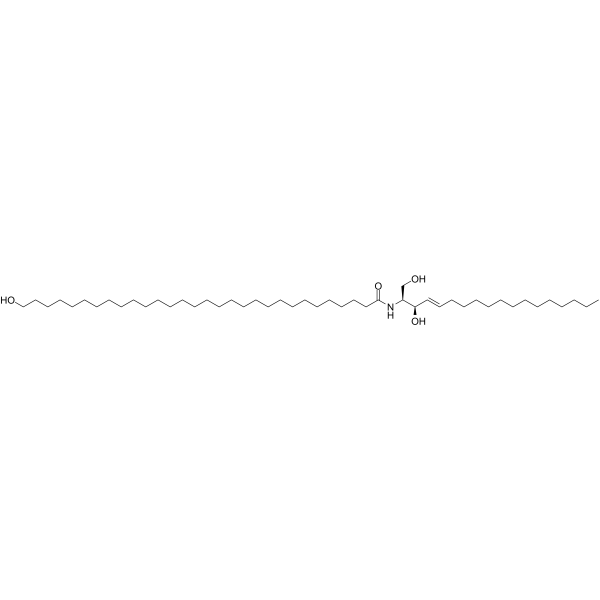
- HY-131708A
-
|
|
HDAC
Parasite
|
Infection
|
|
FNDR-20123 is a safe, first-in-class, and orally active anti-malarial HDAC inhibitor with IC50s of 31 nM and 3 nM for Plasmodium and human HDAC, respectively. FNDR-20123 exerts anti-malarial activity against Plasmodium falciparum asexual stage (IC50=41 nM) and sexual blood stage (IC50=190 nM for male gametocytes). FNDR-20123 inhibits HDAC1, HDAC2, HDAC3, HDAC6, and HDAC8 (IC50=25/29/2/11/282 nM, respectively.) and inhibits Class III HDAC isoforms at nanomolar concentrations .
|
-

- HY-113058
-
|
|
Biochemical Assay Reagents
|
Others
|
|
3-Hydroxyoctanoic acid is a hydroxylated fatty acid that has been found in the LPS of Pseudomonas aeruginosa and in methyl-branched poly(3-hydroxyalkanoate) (PHA) polymers produced by Pseudomonas oleophores. It is an agonist of the orphan receptor GPR109B, increasing intracellular calcium in human neutrophils endogenously expressing GPR109B. 3-Hydroxycaprylic acid prevents lipolysis in human adipocytes and is upregulated in human plasma in response to a ketogenic diet. Plasma levels of 3-hydroxyoctanoic acid were also increased 3.41-fold in human male runners exhausted on a treadmill and in a mouse model of autism spectrum disorder (ASD) fed a high-glycemic diet.
|
-
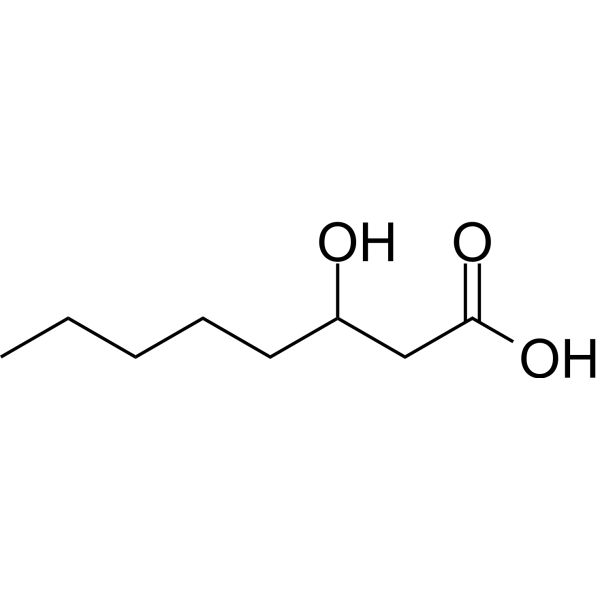
- HY-131708
-
|
|
HDAC
Parasite
|
Infection
|
|
FNDR-20123 free base is a safe, first-in-class, and orally active anti-malarial HDAC inhibitor with IC50s of 31 nM and 3 nM for Plasmodium and human HDAC, respectively. FNDR-20123 free base exerts anti-malarial activity against Plasmodium falciparum asexual stage (IC50=41 nM) and sexual blood stage (IC50=190 nM for male gametocytes). FNDR-20123 free base inhibits HDAC1, HDAC2, HDAC3, HDAC6, and HDAC8 (IC50=25, 29, 2, 11, and 282 nM, respectively) and inhibits Class III HDAC isoforms at nanomolar concentrations .
|
-

- HY-163345
-
|
|
5-HT Receptor
|
Neurological Disease
|
5-HT7R antagonist 2 (compound 4h) is a 5-HT7R antagonist that antagonizes the G protein and β-arrestin signaling pathways, with a Ki of 67 nM, the IC50 values in cAMP and Tango tests were 2.59 μM and 39.57 μM, respectively. 5-HT7R antagonist 2 has an effect on neurogenesis and can reduce repetitive behaviors related to autism spectrum disorder (ASD) and restore neurogenesis of ASD impairment .
Pharmacokinetic Analysis ICR Male Mice
药代动力学分析
| Plasma |
Intravenous Administration |
Intraperitoneal Administration |
| Tmax (h) |
0.08 |
0.25 |
| T1/2 (h) |
0.77 |
1.06 |
| Cmax (ng/mL) |
33.07 |
156.44 |
| AUClast (ng·h/mL) |
28.31 |
143.27 |
| CL (L/h/kg) |
41.61 |
- |
| Vss (L/kg) |
32.43 |
- |
| MRT (h) |
0.79 |
0.93 |
| F (%) |
50.60 |
|
|
-
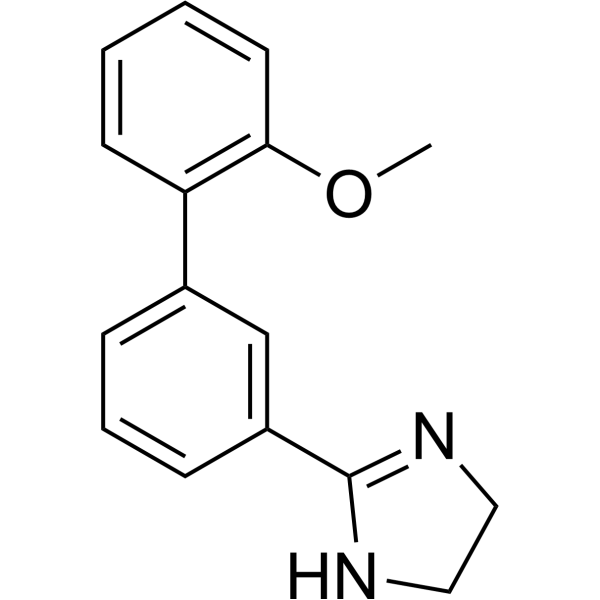
| Cat. No. |
Product Name |
Type |
-
- HY-W127723
-
|
|
Dyes
|
|
Fluoresceinamine Maleic Acid Monoamide is a biochemical reagent that can be used as a biological material or organic compound for life science related research.
|
| Cat. No. |
Product Name |
Type |
-
- HY-113058
-
|
|
Biochemical Assay Reagents
|
|
3-Hydroxyoctanoic acid is a hydroxylated fatty acid that has been found in the LPS of Pseudomonas aeruginosa and in methyl-branched poly(3-hydroxyalkanoate) (PHA) polymers produced by Pseudomonas oleophores. It is an agonist of the orphan receptor GPR109B, increasing intracellular calcium in human neutrophils endogenously expressing GPR109B. 3-Hydroxycaprylic acid prevents lipolysis in human adipocytes and is upregulated in human plasma in response to a ketogenic diet. Plasma levels of 3-hydroxyoctanoic acid were also increased 3.41-fold in human male runners exhausted on a treadmill and in a mouse model of autism spectrum disorder (ASD) fed a high-glycemic diet.
|
-
- HY-W127447
-
|
Maleic acid sodium
|
Biochemical Assay Reagents
|
|
Maleic acid sodium salt is a biochemical reagent that can be used as a biological material or organic compound for life science related research.
|
-
- HY-W250305
-
-
- HY-W250303
-
|
Hydroxybutanedioic acid disodium salt; E 296 disodium salt
|
Biochemical Assay Reagents
|
|
Sodium DL-Malate is an organic compound commonly used as a food additive, buffer and nutritional supplement. It contains sodium and malic acid. Malic acid disodium salt has several properties suitable for these applications, including the ability to enhance food flavor, improve texture and regulate acidity. Additionally, it can be used as a dietary supplement due to its potential health benefits, including improved energy production, reduced fatigue, and enhanced athletic performance.
|
| Cat. No. |
Product Name |
Target |
Research Area |
-
- HY-P1917A
-
|
|
Peptides
|
Inflammation/Immunology
|
|
Uty HY Peptide (246-254) TFA, derived from the ubiquitously transcribed tetratricopeptide repeat gene on the Y chromosome (UTY) protein as an H-Y epitope, H-YD b, is a male-specific transplantation antigen H-Y .
|
-
- HY-P5719
-
|
|
Bacterial
|
Infection
|
|
Andropin is a male-specific antibacterial peptide that can be found in Drosophila melanogaster .
|
-
- HY-139741
-
|
|
Peptides
|
Others
|
|
cyclo(Phe-Ala-Gly-Arg-Arg-Arg-Gly-AEEAc) provides an avenue for developing a nonhormonal male contraceptive by blocking of GRTH/DDX25 phosphorylation.
|
-
- HY-P1917
-
|
|
Peptides
|
Inflammation/Immunology
|
|
Uty HY Peptide (246-254), derived from the ubiquitously transcribed tetratricopeptide repeat gene on the Y chromosome (UTY) protein as an H-Y epitope, H-YD b, is a male-specific transplantation antigen H-Y .
|
-
- HY-P5883
-
|
tatM2NX
|
TRP Channel
|
Neurological Disease
|
|
TAT-M2NX (tatM2NX) is a TRPM2 inhibitor with specific neuroprotective activity in male mice. TAT-M2NX can be used to study ischemic neuronal damage .
|
-
- HY-P1726A
-
|
|
Melanocortin Receptor
|
|
|
MSG606 TFA is a potent human MC1 receptor antagonist (IC50=17 nM). MSG606 TFA also partial agonist at human MC3 and MC5 receptors (EC50 values are 59 and 1300 nM, respectively). MSG606 TFA exhibits binding affinity for A375 melanoma cells in vitro. MSG606 TFA reverses the induced hyperalgesia in female mice, with no effect in male mice.
|
-
- HY-N2466
-
|
MT-I; [Nle4,D-Phe7]-α-MSH
|
Melanocortin Receptor
|
Neurological Disease
Cancer
|
|
Melanotan I is a potent non-selective melanocortin receptor (MCR) agonist. Melanotan I is a synthetic analogue of α-melanocyte stimulating hormone (α-MSH) that stimulates melanogenesis. Melanotan I can induce skin tanning by mimicking the actions of a-MSH on the melanocortin type 1 receptors (MC1R) of melanocytes. Melanotan I can be used for the research of sun-induced skin cancer, melanoma, inflammation and male erectile dysfunction .
|
| Cat. No. |
Product Name |
Category |
Target |
Chemical Structure |
| Cat. No. |
Product Name |
Chemical Structure |
-
- HY-Y1311S
-
|
|
|
Malic acid-d3 is the deuterium labeled Malic acid. Malic acid (Hydroxybutanedioic acid) is a dicarboxylic acid that is naturally found in fruits such as apples and pears. It plays a role in many sour or tart foods[1][2].
|
-

-
- HY-Y1069S
-
|
|
|
(S)-Malic acid-d3 is the deuterium labeled (S)-Malic acid. (S)-Malic acid ((S)-2-Hydroxysuccinic acid) is a dicarboxylic acid in naturally occurring form, contributes to the pleasantly sour taste of fruits and is used as a food additive[1][2].
|
-

-
- HY-Y0367S
-
|
|
|
Maleic Acid-d2 is the deuterium labeled Maleic Acid[1]. Maleic Acid is a Glutamate Decarboxylase (GAD) inhibitor of E. coli and L. monocytogenes[2][3].
|
-

-
- HY-59354S
-
|
|
|
Maleic hydrazide-d2 is the deuterium labeled Maleic hydrazide[1]. Maleic hydrazide is extensively used as a systemic plant growth regulator and as a herbicide. Maleic hydrazide acts as an inhibitor of the synthesis of nucleic acids and proteins[2][3].
|
-

-
- HY-Y1069S3
-
|
|
|
(S)-Malic acid- 13C4 is the 13C labeled S-Malic acid (HY-Y1069)[1].
|
-

-
- HY-119419S
-
|
|
|
Pirimicarb-d6 is the deuterium labeled Diuron. Diuron is a phenylurea herbicide that inhibits photosynthesis by preventing the formation of ATP and NADH. Diuron (2,500 ppm, dietary) increases the incidence of urinary bladder urothelial carcinomas in male
|
-

-
- HY-N6996S
-
|
|
|
Methyl Eugenol- 13C,d3 is the 13C- and deuterium labeled Methyl Eugenol. Methyl Eugenol, a phenylpropanoid chemical in leaves, fruits, stems, and/or roots, may be released when that corresponding part of a plant is damaged as a result of feeding by an herbivore. Methyl Eugenol is used for male annihilation of the oriental fruit fly[1].
|
-

Your information is safe with us. * Required Fields.
Inquiry Information
- Product Name:
- Cat. No.:
- Quantity:
- MCE Japan Authorized Agent:







































































